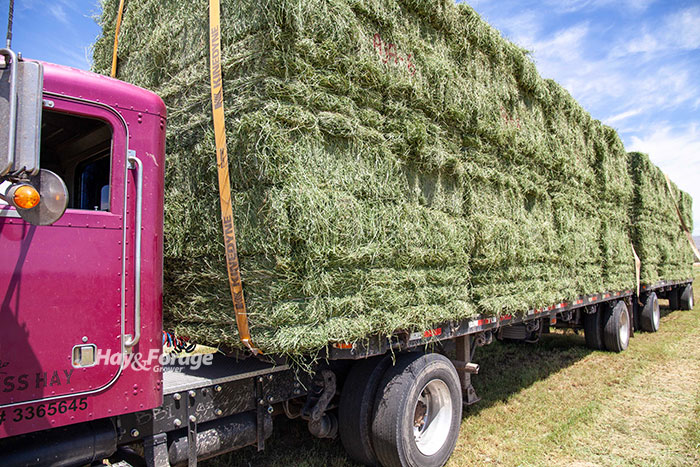Be picky about purchased hay |
| By Amber Friedrichsen, Associate Editor |
|
|
 Some farmers may have lower hay supplies this winter following a dry growing season. Buying hay might seem like a simple solution to fill feed gaps, but the decision to do so can be complex. While sale price tends to be hay buyers’ biggest concern, Ben Beckman with University of Nebraska Extension says there are other factors that could incur additional costs down the road. The extension educator encourages farmers to consider forage quality, potential pests, toxicity issues, and current hay inventories before buying bales. 1. Take a look at test results. Hay quality might be listed in advertisements, but these values may be mere estimates. Beckman notes quality can be influenced by plant species, growing conditions, and maturity at harvest, as well as curing tactics and storage methods. Request to see hay test results to ensure the product will meet animals’ requirements. “Even if a guess is close, a few percentage points either way on energy or protein content can mean the difference between healthy cows during calving and a successful breed back rate, or animals in low body condition and open animals next year,” Beckman says. After confirming hay quality, use this information to compare hay prices. Beckman suggests using tools like the UNL Feed Cost Cow-Q-Lator to determine hay cost per pound of energy or protein by accounting for hay quality, transportation fees, storage costs, and feeding practices. 2. Be aware of potential pests. One risk associated with buying hay is transporting invasive species from farm-to-farm. Various weeds from different regions can wreak havoc on a clean field. Moreover, pests like fire ants can infest hay from Texas and Oklahoma, and alfalfa weevil can come from just about anywhere. Check references and do research about potential pests, and ask sellers if they’ve experienced any issues with invasive species. Beckman says buyers reserve the right to refuse hay after it arrives if it is not safe to feed on their farm. He also recommends feeding purchased hay in isolated areas to minimize problems if pests are present. 3. Don’t tolerate toxic hay. With the exception of prussic acid, the concentration of toxic compounds in forage can remain high in dry hay. For example, hay made from annual grasses and small grains that endured drought stress this year could contain high levels of nitrates. Weeds baled into hay, like pigweed, can be toxic, too. “Because hay is a dried form of the plant and often limit-fed or ground up, animals can end up consuming more weeds than normal as their ability to be selective is decreased,” Beckman asserts. “Keep an eye out for anything unusual in the bale, and try to identify unknown plants, if possible. This may need to be done on a bale-by-bale basis, as some species are patchy in growth and may not show up uniformly across a field,” he adds. Another concern comes from mold growth in wet hay. This can hamper hay quality and induce respiratory issues in cattle. Wet hay may also lead to mycotoxin development, which can lower animal weight gain, and in extreme cases, cause abortion and animal death. 4. Plan ahead for winter weather. After calculating the amount of hay needed for winter feeding, consider worst-case scenarios that may warrant more feed. For instance, adverse weather may inhibit grazing cattle on stockpiled forage, and cold temperatures could delay the start of the grazing season next spring. Consider hay quality to determine hay quantity as well. Ensure the purchased product will meet cows’ nutrient needs during calving and peak lactation. Likewise, buy enough hay if frigid conditions boost animals’ energy demands. Overall, Beckman recommends buying hay from a verified seller and only paying for bales after making a personal assessment. “Feeding animals through the winter is not going to be cheap or easy this year,” Beckman states. “Get a hay test, watch out for invasive hitchhikers, mitigate the risk of toxins, take your planning above and beyond, and be careful if a deal seems too good to be true.”  Amber Friedrichsen Amber Friedrichsen served as the 2021 and 2022 Hay & Forage Grower summer editorial intern. She currently attends Iowa State University where she is majoring in agricultural communications and agronomy. |
